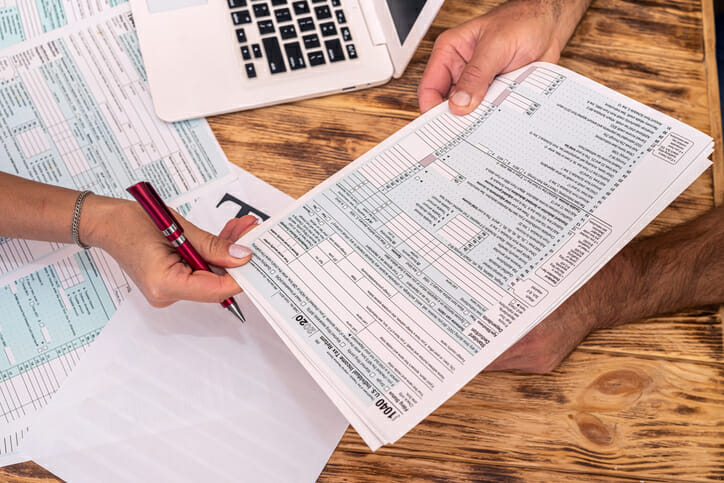Owe back taxes? There are different reasons why you may not have filed your tax return on time. Regardless of what caused you to fall behind, it’s important to get caught up as soon as possible in order to minimize any IRS penalties and fees that may apply. The process for how to file back taxes might seem a little overwhelming but it doesn’t have to be stressful. Here’s what you need to know.
A financial advisor could help optimize your financial plan to reduce your tax liability.
When Do You Need to File Back Taxes?
Most Americans have to file a tax return but there are some instances where you may not need to do so. Generally, you may be exempt from filing a tax return if you:
- Are single
- Under age 65
- Are not self-employed and don’t have other special circumstances that would require you to file
- Earned less than the standard deduction amount for single filers
All of these statements have to be true; otherwise, you likely need to file a tax return, including returns for back taxes. There are, however, some good reasons to file past-due tax returns even if you don’t think you’re required to file.
Benefits of Filing Back Taxes
Filing your tax returns, even if you’re several years behind, can yield some benefits to you. The best reasons to file back taxes include:
- Claiming any uncollected tax refunds you may be owed
- Minimizing IRS penalties and interest
- Earning Social Security benefit credits
- Getting income documentation for loans or credit
You may be hesitant to file back taxes because you assume you’re going to the IRS. It’s possible, however, that you could have a tax refund waiting for you to claim. Remember, tax refunds are essentially interest-free loans you make to the government. So it makes sense to file your back taxes if it means a refund will come your way.
Filing back taxes is also important for putting the brakes on IRS penalties and interest. When you don’t file your tax returns on time, there are two penalties that can apply:
- Failure to file penalty. This penalty is 5% of the unpaid tax due for each month your return is late.
- Failure to pay penalty. This penalty is 0.5% of the unpaid tax due for each month your payment is late.
The IRS caps both of these penalties but being charged either one could still result in significant amounts owed to the government. And there’s no cap on interest due on back taxes which is another good reason to get your returns in sooner rather than later.
Aside from these issues, failing to file tax returns on time can affect your Social Security credits and your ability to qualify for loans. Specifically, it behooves you to file your returns if you’re self-employed to report your income. Failure to do so can directly affect the amount of Social Security benefits you’re able to receive in retirement.
Finally, the IRS cautions taxpayers that failing to file back taxes can affect their ability to qualify for loans. If you want to buy a home, for example, a lender will want to see your prior year’s tax returns along with pay stubs, W-2s and other documentation. Getting a mortgage could be more difficult if you don’t have the necessary tax forms to verify your income.
How to File Back Taxes

Filing back taxes is something you can do on your own but if you have a more complicated return, you may want to enlist the help of a tax professional. In either case, the steps for filing back taxes are the same:
- Organize your information and documents
- Track down any missing documents, if necessary
- Complete your tax return
- Arrange for payment of any taxes due, if applicable
There are some basic things you’ll need to complete your back tax returns. For example, if you work a regular job you’ll need W-2s from your employer. If you’re self-employed, you’ll need 1099s from your clients. You’ll also need receipts or documentation for any expenses you plan to deduct, including charitable donations, business expenses, mortgage interest and student loan interest.
If you’re missing some of these documents, you’ll need to get copies of them in order to file your back tax return. This usually means reaching out to your current or previous employers or clients if you’re self-employed to request copies of W-2s or 1099s. As a last resort, you can also contact the IRS to request a wage and income transcript, which will show W-2 and 1099 income that was reported to the federal government on your behalf.
You’ll also need to collect documentation for income that comes from things other than working. So if you took money from an IRA or 401(k), for example, you’ll need a tax form showing the amount of the distribution. You’ll also need documents showing any income received from Social Security or federal retirement benefit plans you’re enrolled in.
Once you’ve got your documentation you can start filling out your tax return. If you’re not sure which tax forms to use and you’re filing back taxes on your own, it may be easier to use an online tax filing software. Online tax programs will ask you questions about your tax filing status, income and deductions to determine which form or forms you need to complete. These programs can also walk you through each field on the return that you need to fill out.
When you’re done with your tax forms, you can submit them to the IRS. If the software program also calculated your state taxes you can submit those forms to your state tax agency. Keep in mind that you’ll need to print the forms out and mail them in both cases. The IRS does not accept back tax returns online. If you owe taxes, you’ll need to send in a check with your returns.
What If You Can’t Pay Back Taxes

It’s possible that completing back taxes will result in a tax bill. If you can’t pay in full right away, then you have some options. First, you can request a short-term payment plan. The IRS grants short-term payment plans to taxpayers who owe less than $100,000 and can pay their balance due within 180 days. If that’s not enough time you could ask for an installment agreement instead.
With an installment agreement, you can take longer to pay through automatic monthly installments. But this payment option is limited to individual taxpayers who owe less than $50,000 in back taxes and business filers who owe less than $25,000.
The third possibility is an offer of compromise. An offer in compromise is an arrangement in which the IRS agrees to accept less than what’s owed. The IRS considers applications for offers in compromise on a case-by-case basis and acceptance is automatic. It can also take much longer to get approval for an offer in compromise versus an online payment plan or installment agreement.
Bottom Line
If you haven’t filed a tax return lately, the most important thing is to not panic. Knowing how to file back taxes and what’s involved can make the process feel a little less intimidating. Keep in mind that you’re only required to file the last six years of tax returns in order to stay in good standing with the IRS. But filing promptly can help you avoid missing out on tax credits or refunds.
Tax Planning Tips
- Consider talking to your financial advisor about how to file back taxes if you’ve fallen behind. Finding a financial advisor doesn’t have to be hard. SmartAsset’s free tool matches you with up to three vetted financial advisors who serve your area, and you can have a free introductory call with your advisor matches to decide which one you feel is right for you. If you’re ready to find an advisor who can help you achieve your financial goals, get started now.
- It may be worth hiring a tax professional to help you get caught up on back taxes if you’re several years behind or you have a more complicated return. A tax expert can help you to track down lost documentation, find every deduction and credit you’re eligible to claim and aid in the process of applying for a payment plan, installment agreement or offer in compromise if any of those are necessary.
Photo credit: ©iStock.com/mediaphotos, ©iStock.com/alfexe, ©iStock.com/alfexe
